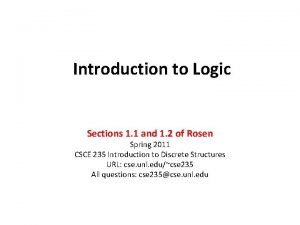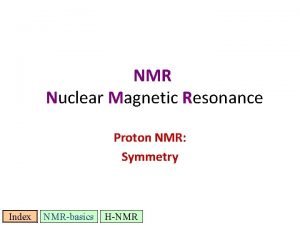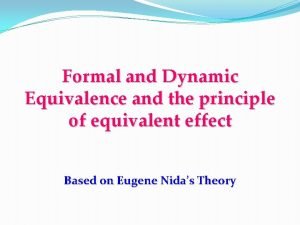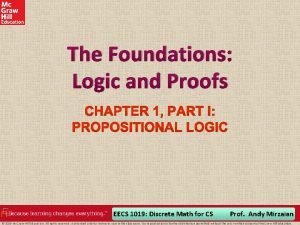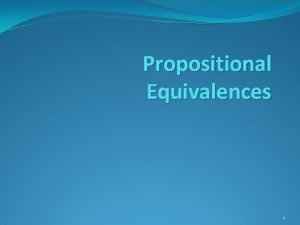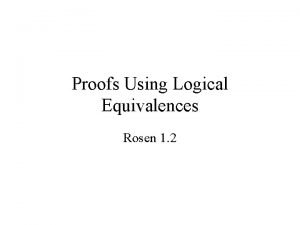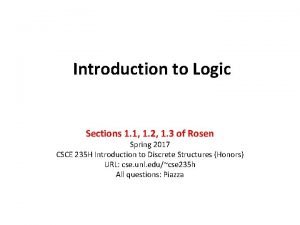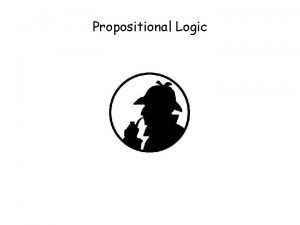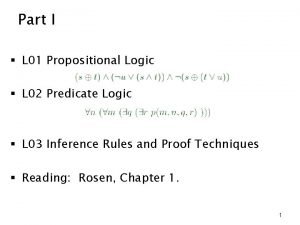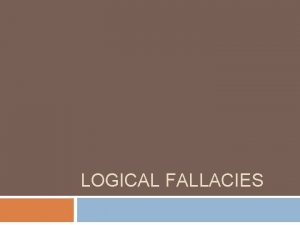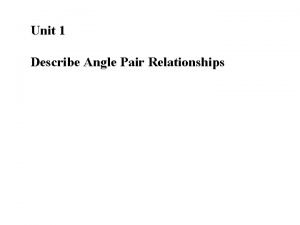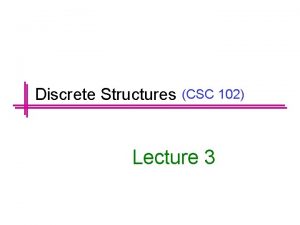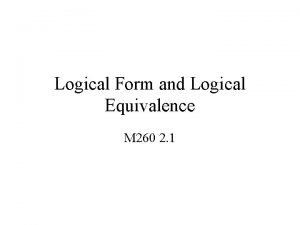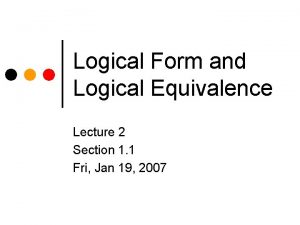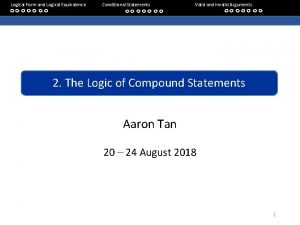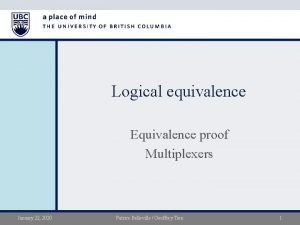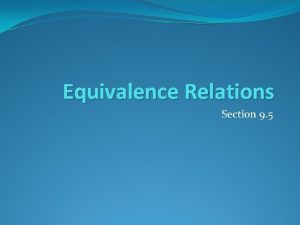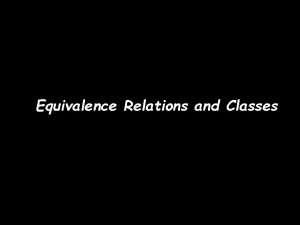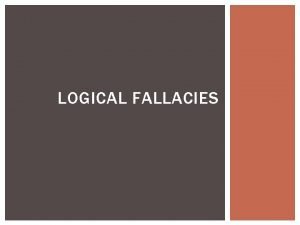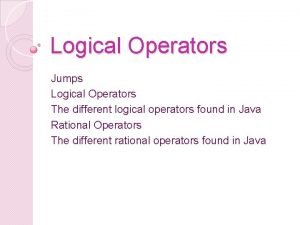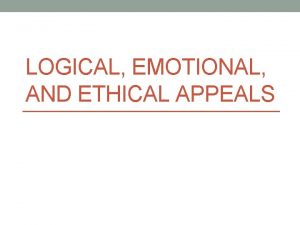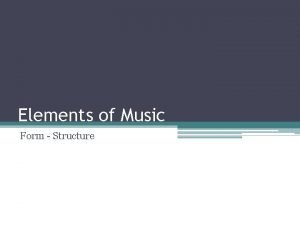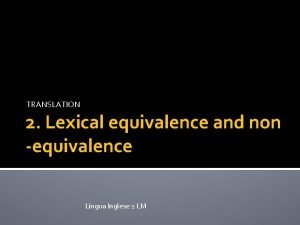Logical Equivalence Definition Two proposition form are called



















- Slides: 19

Logical Equivalence Definition Two proposition form are called logically equivalent if and only if they have identical truth values for each possible substitution of propositions for their proposition variable. The logical equivalence of proposition forms P and Q is written P ≡Q

Equivalence of Two Compound Propositions P and Q 1. Construct the truth table for P. 2. Construct the truth table for Q using the same proposition variables for identical component propositions. 3. Check each combination of truth values of the proposition variables to see whether the truth value of P is the same as the truth value of Q.

Equivalence Check a. If in each row the truth value of P is the same as the truth value of Q, then P and Q are logically equivalent. b. If in some row P has a different truth value from Q, then P and Q are not logically equivalent.

Example • Prove that ¬ (¬p)≡ p Solution p T F ¬p F T ¬ (¬p) T F As you can see the corresponding truth values of p and ¬ (¬p) are same, hence equivalence is justified.

Example Show that the proposition forms ¬(p q) and ¬p ¬q are NOT logically equivalent. p T T F F q T F ¬p F F T T ¬q F T (p q) ¬p ¬q T F F T T T F F F T Here the corresponding truth values differ and hence equivalence does not hold

De Morgan’s laws state that: The negation of an and proposition is logically equivalent to the or proposition in which each component is negated. The negation of an or proposition is logically equivalent to the and proposition in which each component is negated.

Symbolically (De Morgan’s Laws) 1. ¬(p q) ≡ ¬p ¬q 2. ¬(p q) ≡ ¬p ¬q

Applying De-Morgan’s Law Question: Negate the following compound Propositions 1. John is six feet tall and he weights at least 200 pounds. 2. The bus was late or Tom’s watch was slow.

Solution a) John is not six feet tall or he weighs less than 200 pounds. b) The bus was not late and Tom’s watch was not slow.

Inequalities and De Morgan’s Laws Question Use De Morgan’s laws to write the negation of -1< x 4 Solution: The given proposition is equivalent to -1 < x and x 4, By De Morgan’s laws, the negation is -1 ≥ x or x > 4.

Tautology and Contradiction Definition A tautology is a proposition form that is always true regardless of the truth values of the individual propositions substituted for its proposition variables. A proposition whose form is a tautology is called a tautological proposition. Definition A contradiction is a proposition form that is always false regardless of the truth values of the individual propositions substituted for its proposition variables. A proposition whose form is a contradiction is called a contradictory proposition.

Example Show that the proposition form p ¬p is a tautology and the proposition form p ¬p is a contradiction. p ¬p T F F T T F Exercise: If t is a tautology and c is contradiction, show that p t≡p and p c≡c?

Laws of Logic 1. Commutative laws p q ≡ q p ; p q ≡ q p 2. Associative laws p (q r) ≡ (p q) r ; p (q r) ≡ (p q) r 3. Distributive laws p (q r ) ≡ (p q) (p r) p (q r) ≡ (p q) (p r)

Laws of Logic 4. Identity laws p t ≡ p ; p c ≡ p 5. Negation laws p ¬p ≡ t ; p ¬p ≡ c 6. Double negation law ¬(¬p) ≡ p 7. Idempotent laws p p ≡ p ; p p ≡ p

Laws of Logic 8. Universal bound laws p t≡ t ; p c ≡ c 9. Absorption laws p (p q) ≡ p ; p (p q) ≡ p 10. Negation of t and c ¬t ≡ c ; ¬c ≡ t

17

Exercise Using laws of logic, show that ⌐(⌐p q) (p q) ≡ p. Solution Take ⌐(⌐p q) (p q) ≡ (⌐(⌐p) ⌐q) (p q), (by De Morgan’s laws) ≡ (p ⌐q) (p q), ≡ p (⌐q q), (by double negative law) (by distributive law)

contd… ≡ p (q ⌐q), (by the commutative law) ≡ p c, (by the negation law) ≡ p, (by the identity law) Skill in simplifying proposition forms is useful in constructing logically efficient computer programs and in designing digital circuits.

Thank You 20
 Logically equivalent statements
Logically equivalent statements Logical form and logical equivalence
Logical form and logical equivalence Insidan region jh
Insidan region jh Logical connectives
Logical connectives Magnetically equivalent protons
Magnetically equivalent protons Formal dynamic equivalence
Formal dynamic equivalence Equivalence and equivalent effect in translation studies
Equivalence and equivalent effect in translation studies Logical equivalence
Logical equivalence De morgan's second theorem truth table
De morgan's second theorem truth table Logic equivalence
Logic equivalence Proof by contradiction discrete math
Proof by contradiction discrete math Logical connectives
Logical connectives Propositional form
Propositional form 5 examples of proposition
5 examples of proposition Logical fallacy
Logical fallacy Applications of propositional logic
Applications of propositional logic Logical equivalence
Logical equivalence Universal affirmative
Universal affirmative Describing supplementary angle relationships
Describing supplementary angle relationships Conditional proposition examples
Conditional proposition examples



